Systems Analysis & Design Project - SDLC, Agile, Hilton Hotel Analysis
VerifiedAdded on 2021/02/20
|20
|4307
|479
Project
AI Summary
This Systems Analysis & Design project comprehensively examines the Systems Development Life Cycle (SDLC), detailing its stages and the crucial role of a system analyst within each. It contrasts the Agile and Waterfall methodologies, highlighting their differences and appropriate applications in software development. The project then focuses on a case study of the Hilton Hotel, outlining the purpose of a chosen application, identifying stakeholders, and specifying both functional and non-functional requirements. Furthermore, it includes the creation of essential diagrams such as a context diagram, Data Flow Diagrams (DFDs) at levels 1 and 2, a use case diagram, and an Entity-Relationship Diagram (ERD) to visually represent the system's structure and processes. The analysis aims to understand the hotel's operations, customer interactions, and the impact of technology on its services, providing a holistic view of systems analysis and design principles within a real-world context.
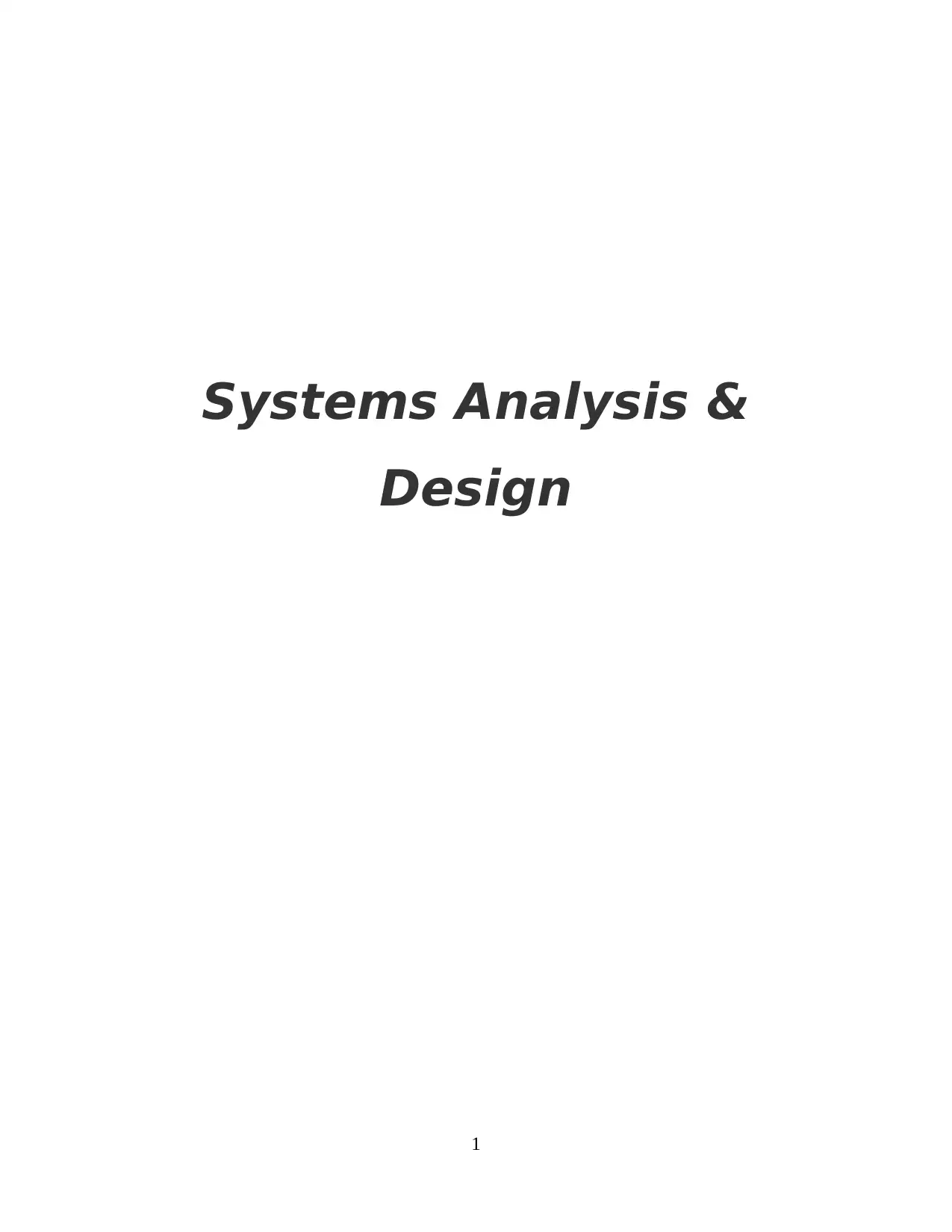
Systems Analysis &
Design
1
Design
1
Paraphrase This Document
Need a fresh take? Get an instant paraphrase of this document with our AI Paraphraser
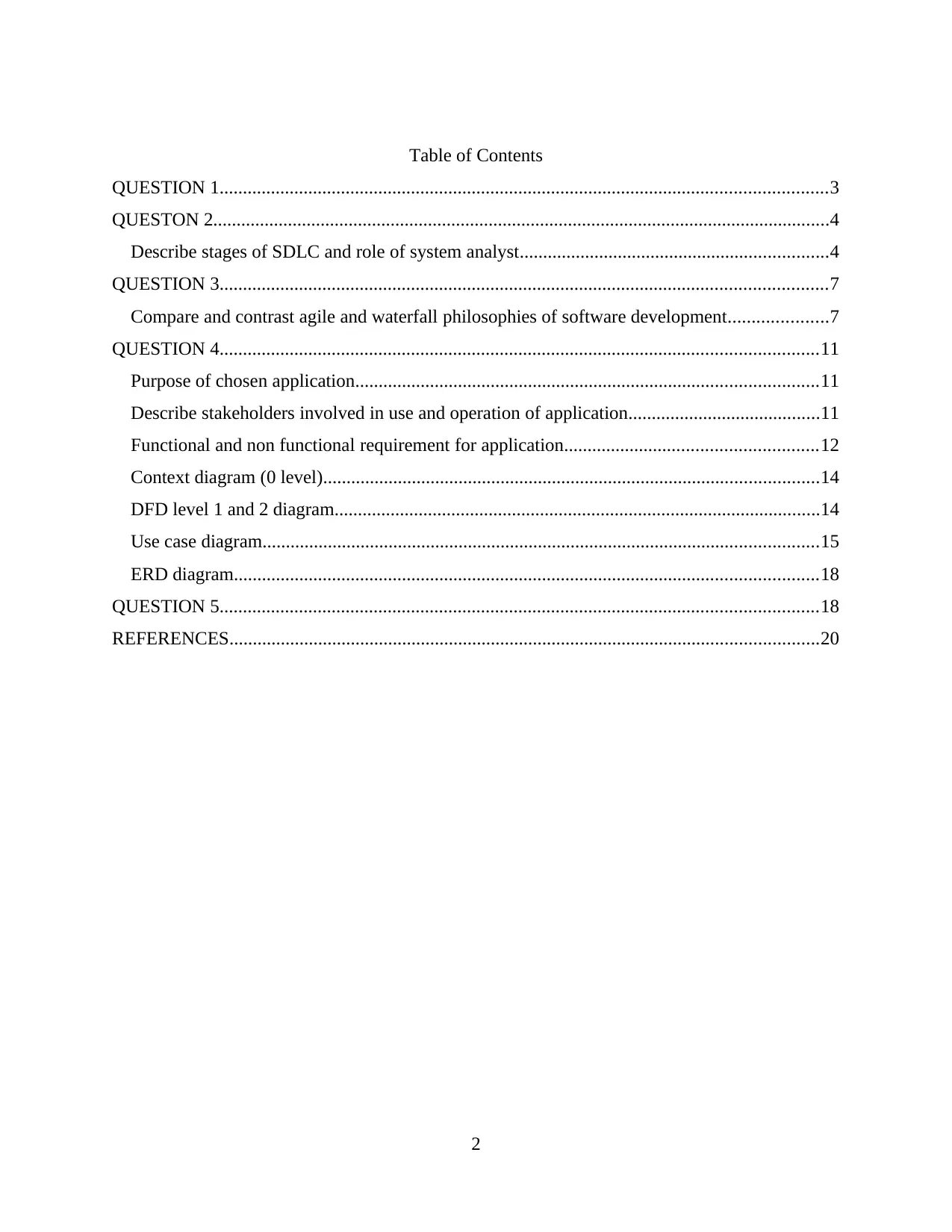
Table of Contents
QUESTION 1..................................................................................................................................3
QUESTON 2....................................................................................................................................4
Describe stages of SDLC and role of system analyst..................................................................4
QUESTION 3..................................................................................................................................7
Compare and contrast agile and waterfall philosophies of software development.....................7
QUESTION 4................................................................................................................................11
Purpose of chosen application...................................................................................................11
Describe stakeholders involved in use and operation of application.........................................11
Functional and non functional requirement for application......................................................12
Context diagram (0 level)..........................................................................................................14
DFD level 1 and 2 diagram........................................................................................................14
Use case diagram.......................................................................................................................15
ERD diagram.............................................................................................................................18
QUESTION 5................................................................................................................................18
REFERENCES..............................................................................................................................20
2
QUESTION 1..................................................................................................................................3
QUESTON 2....................................................................................................................................4
Describe stages of SDLC and role of system analyst..................................................................4
QUESTION 3..................................................................................................................................7
Compare and contrast agile and waterfall philosophies of software development.....................7
QUESTION 4................................................................................................................................11
Purpose of chosen application...................................................................................................11
Describe stakeholders involved in use and operation of application.........................................11
Functional and non functional requirement for application......................................................12
Context diagram (0 level)..........................................................................................................14
DFD level 1 and 2 diagram........................................................................................................14
Use case diagram.......................................................................................................................15
ERD diagram.............................................................................................................................18
QUESTION 5................................................................................................................................18
REFERENCES..............................................................................................................................20
2
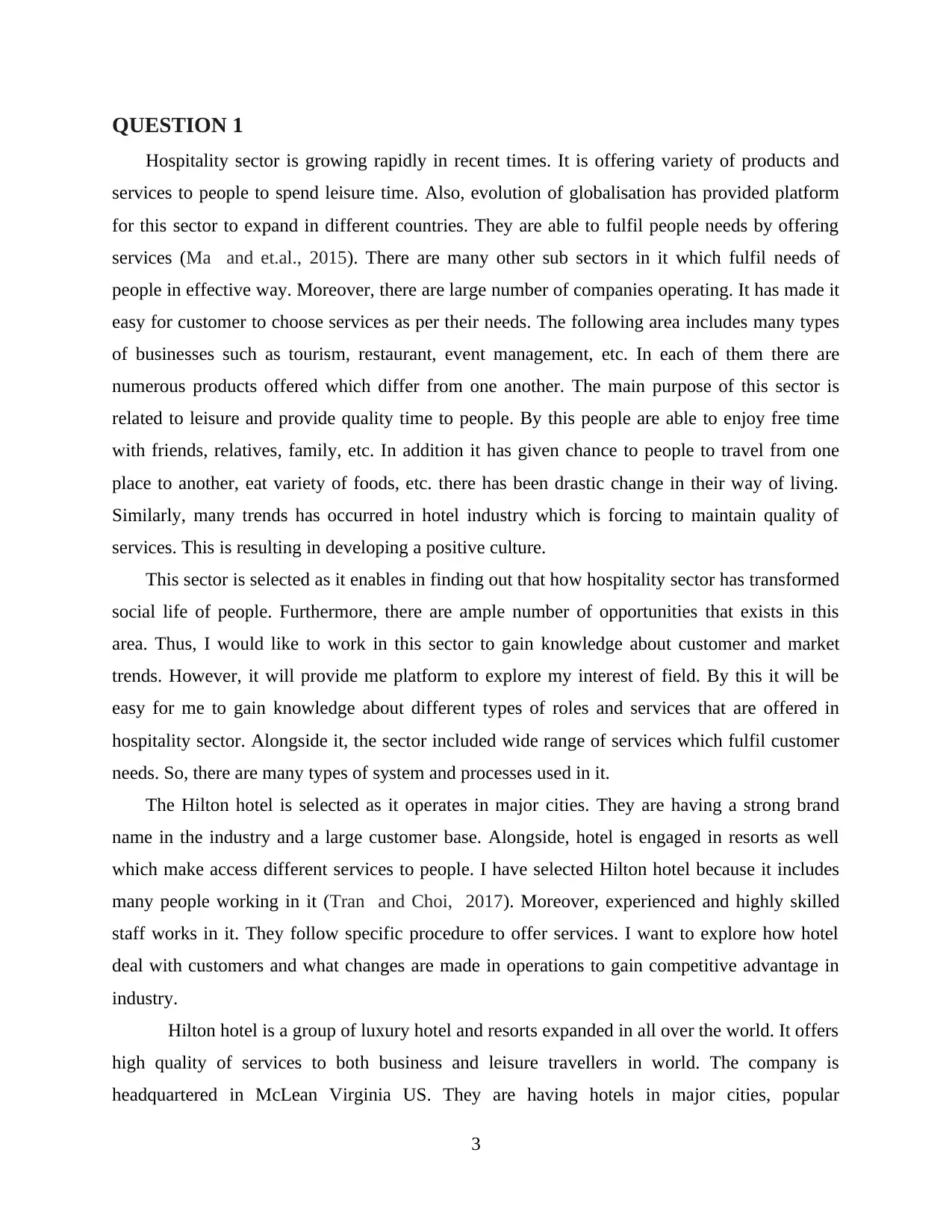
QUESTION 1
Hospitality sector is growing rapidly in recent times. It is offering variety of products and
services to people to spend leisure time. Also, evolution of globalisation has provided platform
for this sector to expand in different countries. They are able to fulfil people needs by offering
services (Ma and et.al., 2015). There are many other sub sectors in it which fulfil needs of
people in effective way. Moreover, there are large number of companies operating. It has made it
easy for customer to choose services as per their needs. The following area includes many types
of businesses such as tourism, restaurant, event management, etc. In each of them there are
numerous products offered which differ from one another. The main purpose of this sector is
related to leisure and provide quality time to people. By this people are able to enjoy free time
with friends, relatives, family, etc. In addition it has given chance to people to travel from one
place to another, eat variety of foods, etc. there has been drastic change in their way of living.
Similarly, many trends has occurred in hotel industry which is forcing to maintain quality of
services. This is resulting in developing a positive culture.
This sector is selected as it enables in finding out that how hospitality sector has transformed
social life of people. Furthermore, there are ample number of opportunities that exists in this
area. Thus, I would like to work in this sector to gain knowledge about customer and market
trends. However, it will provide me platform to explore my interest of field. By this it will be
easy for me to gain knowledge about different types of roles and services that are offered in
hospitality sector. Alongside it, the sector included wide range of services which fulfil customer
needs. So, there are many types of system and processes used in it.
The Hilton hotel is selected as it operates in major cities. They are having a strong brand
name in the industry and a large customer base. Alongside, hotel is engaged in resorts as well
which make access different services to people. I have selected Hilton hotel because it includes
many people working in it (Tran and Choi, 2017). Moreover, experienced and highly skilled
staff works in it. They follow specific procedure to offer services. I want to explore how hotel
deal with customers and what changes are made in operations to gain competitive advantage in
industry.
Hilton hotel is a group of luxury hotel and resorts expanded in all over the world. It offers
high quality of services to both business and leisure travellers in world. The company is
headquartered in McLean Virginia US. They are having hotels in major cities, popular
3
Hospitality sector is growing rapidly in recent times. It is offering variety of products and
services to people to spend leisure time. Also, evolution of globalisation has provided platform
for this sector to expand in different countries. They are able to fulfil people needs by offering
services (Ma and et.al., 2015). There are many other sub sectors in it which fulfil needs of
people in effective way. Moreover, there are large number of companies operating. It has made it
easy for customer to choose services as per their needs. The following area includes many types
of businesses such as tourism, restaurant, event management, etc. In each of them there are
numerous products offered which differ from one another. The main purpose of this sector is
related to leisure and provide quality time to people. By this people are able to enjoy free time
with friends, relatives, family, etc. In addition it has given chance to people to travel from one
place to another, eat variety of foods, etc. there has been drastic change in their way of living.
Similarly, many trends has occurred in hotel industry which is forcing to maintain quality of
services. This is resulting in developing a positive culture.
This sector is selected as it enables in finding out that how hospitality sector has transformed
social life of people. Furthermore, there are ample number of opportunities that exists in this
area. Thus, I would like to work in this sector to gain knowledge about customer and market
trends. However, it will provide me platform to explore my interest of field. By this it will be
easy for me to gain knowledge about different types of roles and services that are offered in
hospitality sector. Alongside it, the sector included wide range of services which fulfil customer
needs. So, there are many types of system and processes used in it.
The Hilton hotel is selected as it operates in major cities. They are having a strong brand
name in the industry and a large customer base. Alongside, hotel is engaged in resorts as well
which make access different services to people. I have selected Hilton hotel because it includes
many people working in it (Tran and Choi, 2017). Moreover, experienced and highly skilled
staff works in it. They follow specific procedure to offer services. I want to explore how hotel
deal with customers and what changes are made in operations to gain competitive advantage in
industry.
Hilton hotel is a group of luxury hotel and resorts expanded in all over the world. It offers
high quality of services to both business and leisure travellers in world. The company is
headquartered in McLean Virginia US. They are having hotels in major cities, popular
3
⊘ This is a preview!⊘
Do you want full access?
Subscribe today to unlock all pages.

Trusted by 1+ million students worldwide
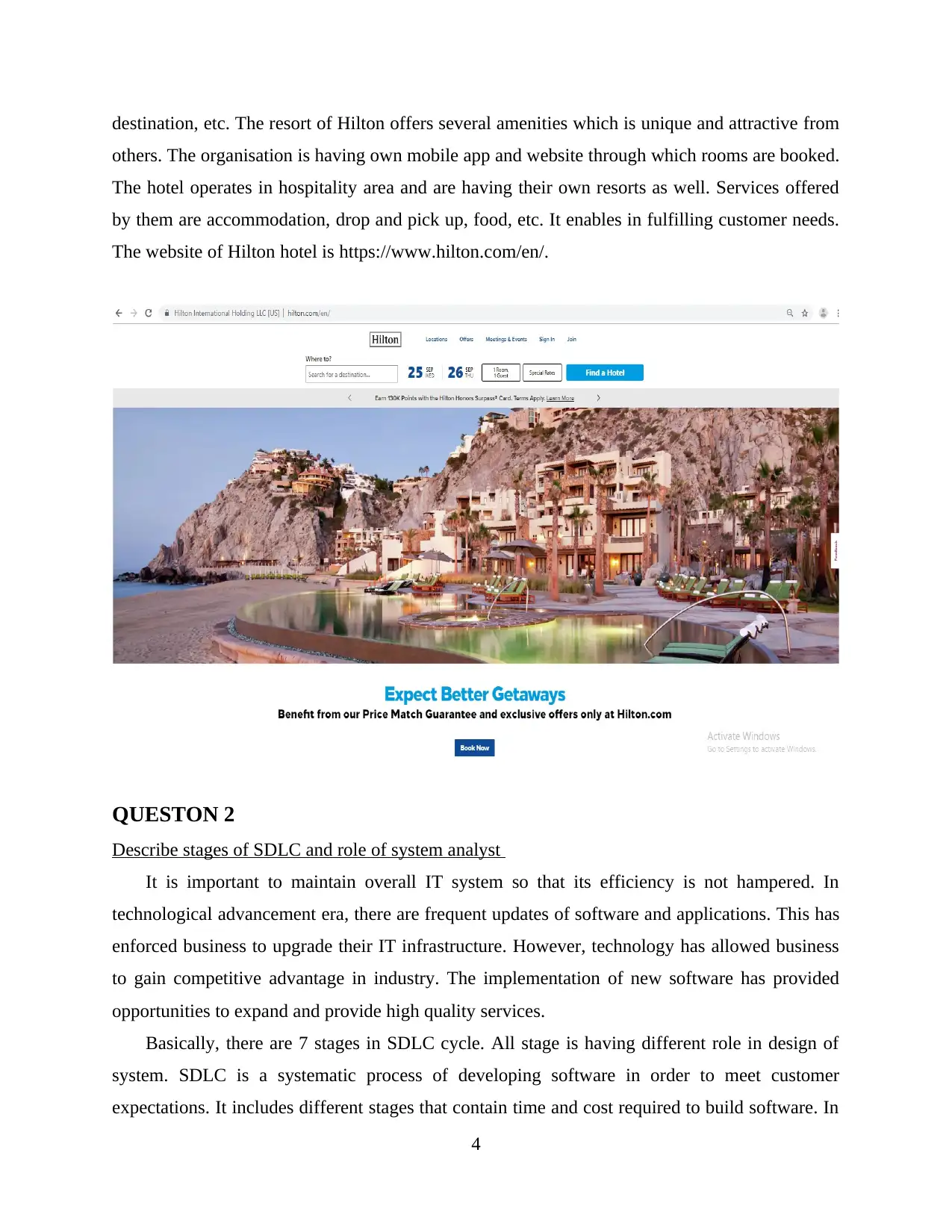
destination, etc. The resort of Hilton offers several amenities which is unique and attractive from
others. The organisation is having own mobile app and website through which rooms are booked.
The hotel operates in hospitality area and are having their own resorts as well. Services offered
by them are accommodation, drop and pick up, food, etc. It enables in fulfilling customer needs.
The website of Hilton hotel is https://www.hilton.com/en/.
QUESTON 2
Describe stages of SDLC and role of system analyst
It is important to maintain overall IT system so that its efficiency is not hampered. In
technological advancement era, there are frequent updates of software and applications. This has
enforced business to upgrade their IT infrastructure. However, technology has allowed business
to gain competitive advantage in industry. The implementation of new software has provided
opportunities to expand and provide high quality services.
Basically, there are 7 stages in SDLC cycle. All stage is having different role in design of
system. SDLC is a systematic process of developing software in order to meet customer
expectations. It includes different stages that contain time and cost required to build software. In
4
others. The organisation is having own mobile app and website through which rooms are booked.
The hotel operates in hospitality area and are having their own resorts as well. Services offered
by them are accommodation, drop and pick up, food, etc. It enables in fulfilling customer needs.
The website of Hilton hotel is https://www.hilton.com/en/.
QUESTON 2
Describe stages of SDLC and role of system analyst
It is important to maintain overall IT system so that its efficiency is not hampered. In
technological advancement era, there are frequent updates of software and applications. This has
enforced business to upgrade their IT infrastructure. However, technology has allowed business
to gain competitive advantage in industry. The implementation of new software has provided
opportunities to expand and provide high quality services.
Basically, there are 7 stages in SDLC cycle. All stage is having different role in design of
system. SDLC is a systematic process of developing software in order to meet customer
expectations. It includes different stages that contain time and cost required to build software. In
4
Paraphrase This Document
Need a fresh take? Get an instant paraphrase of this document with our AI Paraphraser
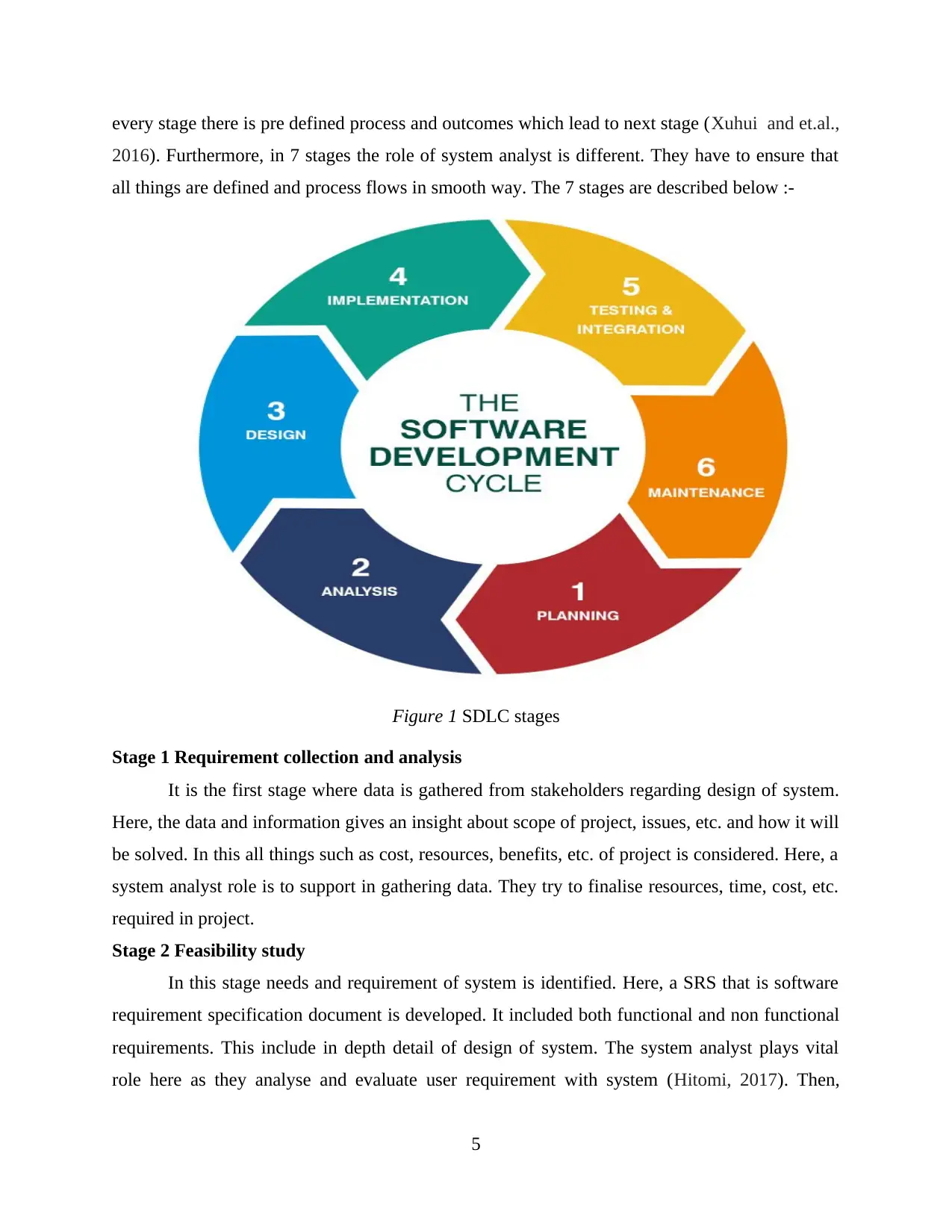
every stage there is pre defined process and outcomes which lead to next stage (Xuhui and et.al.,
2016). Furthermore, in 7 stages the role of system analyst is different. They have to ensure that
all things are defined and process flows in smooth way. The 7 stages are described below :-
Figure 1 SDLC stages
Stage 1 Requirement collection and analysis
It is the first stage where data is gathered from stakeholders regarding design of system.
Here, the data and information gives an insight about scope of project, issues, etc. and how it will
be solved. In this all things such as cost, resources, benefits, etc. of project is considered. Here, a
system analyst role is to support in gathering data. They try to finalise resources, time, cost, etc.
required in project.
Stage 2 Feasibility study
In this stage needs and requirement of system is identified. Here, a SRS that is software
requirement specification document is developed. It included both functional and non functional
requirements. This include in depth detail of design of system. The system analyst plays vital
role here as they analyse and evaluate user requirement with system (Hitomi, 2017). Then,
5
2016). Furthermore, in 7 stages the role of system analyst is different. They have to ensure that
all things are defined and process flows in smooth way. The 7 stages are described below :-
Figure 1 SDLC stages
Stage 1 Requirement collection and analysis
It is the first stage where data is gathered from stakeholders regarding design of system.
Here, the data and information gives an insight about scope of project, issues, etc. and how it will
be solved. In this all things such as cost, resources, benefits, etc. of project is considered. Here, a
system analyst role is to support in gathering data. They try to finalise resources, time, cost, etc.
required in project.
Stage 2 Feasibility study
In this stage needs and requirement of system is identified. Here, a SRS that is software
requirement specification document is developed. It included both functional and non functional
requirements. This include in depth detail of design of system. The system analyst plays vital
role here as they analyse and evaluate user requirement with system (Hitomi, 2017). Then,
5
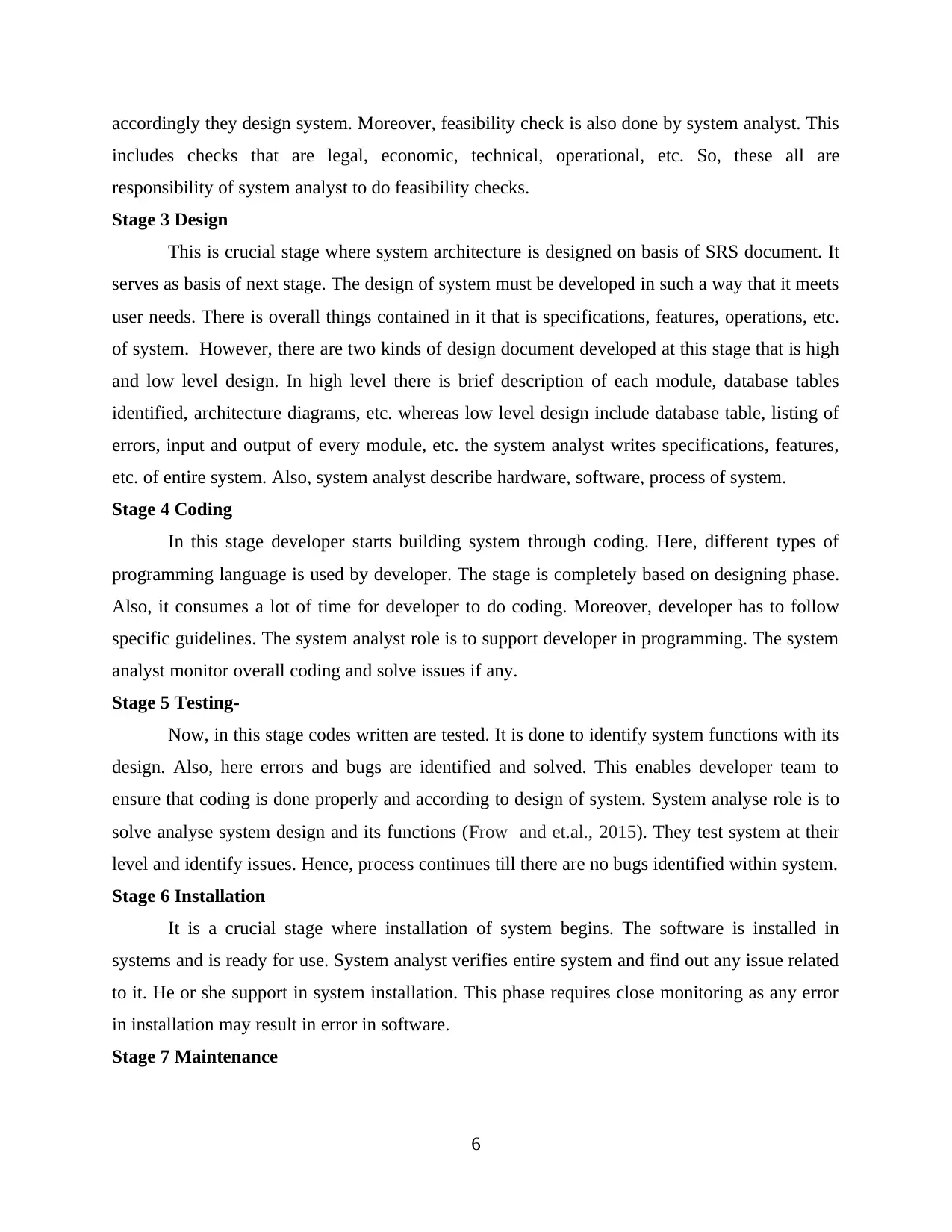
accordingly they design system. Moreover, feasibility check is also done by system analyst. This
includes checks that are legal, economic, technical, operational, etc. So, these all are
responsibility of system analyst to do feasibility checks.
Stage 3 Design
This is crucial stage where system architecture is designed on basis of SRS document. It
serves as basis of next stage. The design of system must be developed in such a way that it meets
user needs. There is overall things contained in it that is specifications, features, operations, etc.
of system. However, there are two kinds of design document developed at this stage that is high
and low level design. In high level there is brief description of each module, database tables
identified, architecture diagrams, etc. whereas low level design include database table, listing of
errors, input and output of every module, etc. the system analyst writes specifications, features,
etc. of entire system. Also, system analyst describe hardware, software, process of system.
Stage 4 Coding
In this stage developer starts building system through coding. Here, different types of
programming language is used by developer. The stage is completely based on designing phase.
Also, it consumes a lot of time for developer to do coding. Moreover, developer has to follow
specific guidelines. The system analyst role is to support developer in programming. The system
analyst monitor overall coding and solve issues if any.
Stage 5 Testing-
Now, in this stage codes written are tested. It is done to identify system functions with its
design. Also, here errors and bugs are identified and solved. This enables developer team to
ensure that coding is done properly and according to design of system. System analyse role is to
solve analyse system design and its functions (Frow and et.al., 2015). They test system at their
level and identify issues. Hence, process continues till there are no bugs identified within system.
Stage 6 Installation
It is a crucial stage where installation of system begins. The software is installed in
systems and is ready for use. System analyst verifies entire system and find out any issue related
to it. He or she support in system installation. This phase requires close monitoring as any error
in installation may result in error in software.
Stage 7 Maintenance
6
includes checks that are legal, economic, technical, operational, etc. So, these all are
responsibility of system analyst to do feasibility checks.
Stage 3 Design
This is crucial stage where system architecture is designed on basis of SRS document. It
serves as basis of next stage. The design of system must be developed in such a way that it meets
user needs. There is overall things contained in it that is specifications, features, operations, etc.
of system. However, there are two kinds of design document developed at this stage that is high
and low level design. In high level there is brief description of each module, database tables
identified, architecture diagrams, etc. whereas low level design include database table, listing of
errors, input and output of every module, etc. the system analyst writes specifications, features,
etc. of entire system. Also, system analyst describe hardware, software, process of system.
Stage 4 Coding
In this stage developer starts building system through coding. Here, different types of
programming language is used by developer. The stage is completely based on designing phase.
Also, it consumes a lot of time for developer to do coding. Moreover, developer has to follow
specific guidelines. The system analyst role is to support developer in programming. The system
analyst monitor overall coding and solve issues if any.
Stage 5 Testing-
Now, in this stage codes written are tested. It is done to identify system functions with its
design. Also, here errors and bugs are identified and solved. This enables developer team to
ensure that coding is done properly and according to design of system. System analyse role is to
solve analyse system design and its functions (Frow and et.al., 2015). They test system at their
level and identify issues. Hence, process continues till there are no bugs identified within system.
Stage 6 Installation
It is a crucial stage where installation of system begins. The software is installed in
systems and is ready for use. System analyst verifies entire system and find out any issue related
to it. He or she support in system installation. This phase requires close monitoring as any error
in installation may result in error in software.
Stage 7 Maintenance
6
⊘ This is a preview!⊘
Do you want full access?
Subscribe today to unlock all pages.

Trusted by 1+ million students worldwide
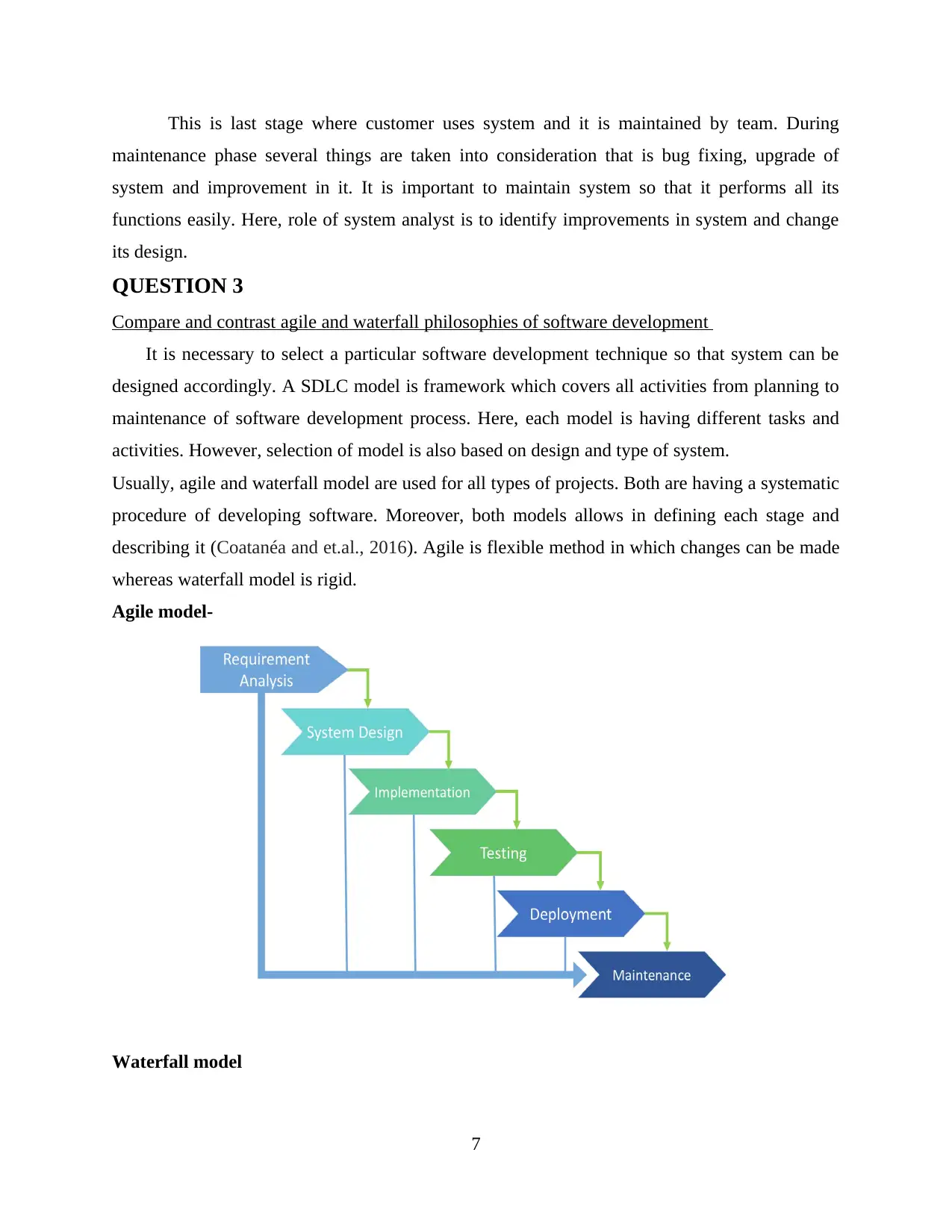
This is last stage where customer uses system and it is maintained by team. During
maintenance phase several things are taken into consideration that is bug fixing, upgrade of
system and improvement in it. It is important to maintain system so that it performs all its
functions easily. Here, role of system analyst is to identify improvements in system and change
its design.
QUESTION 3
Compare and contrast agile and waterfall philosophies of software development
It is necessary to select a particular software development technique so that system can be
designed accordingly. A SDLC model is framework which covers all activities from planning to
maintenance of software development process. Here, each model is having different tasks and
activities. However, selection of model is also based on design and type of system.
Usually, agile and waterfall model are used for all types of projects. Both are having a systematic
procedure of developing software. Moreover, both models allows in defining each stage and
describing it (Coatanéa and et.al., 2016). Agile is flexible method in which changes can be made
whereas waterfall model is rigid.
Agile model-
Waterfall model
7
maintenance phase several things are taken into consideration that is bug fixing, upgrade of
system and improvement in it. It is important to maintain system so that it performs all its
functions easily. Here, role of system analyst is to identify improvements in system and change
its design.
QUESTION 3
Compare and contrast agile and waterfall philosophies of software development
It is necessary to select a particular software development technique so that system can be
designed accordingly. A SDLC model is framework which covers all activities from planning to
maintenance of software development process. Here, each model is having different tasks and
activities. However, selection of model is also based on design and type of system.
Usually, agile and waterfall model are used for all types of projects. Both are having a systematic
procedure of developing software. Moreover, both models allows in defining each stage and
describing it (Coatanéa and et.al., 2016). Agile is flexible method in which changes can be made
whereas waterfall model is rigid.
Agile model-
Waterfall model
7
Paraphrase This Document
Need a fresh take? Get an instant paraphrase of this document with our AI Paraphraser
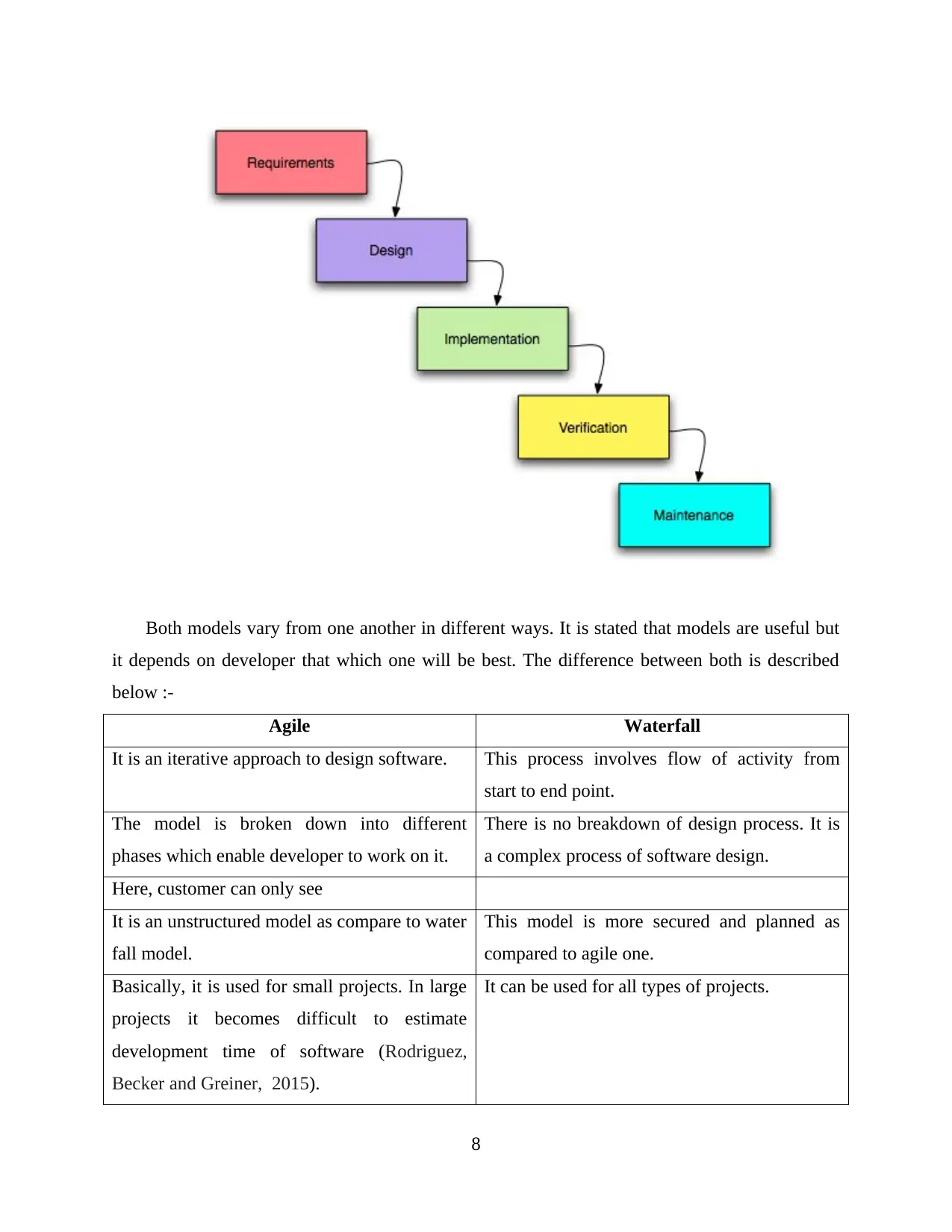
Both models vary from one another in different ways. It is stated that models are useful but
it depends on developer that which one will be best. The difference between both is described
below :-
Agile Waterfall
It is an iterative approach to design software. This process involves flow of activity from
start to end point.
The model is broken down into different
phases which enable developer to work on it.
There is no breakdown of design process. It is
a complex process of software design.
Here, customer can only see
It is an unstructured model as compare to water
fall model.
This model is more secured and planned as
compared to agile one.
Basically, it is used for small projects. In large
projects it becomes difficult to estimate
development time of software (Rodriguez,
Becker and Greiner, 2015).
It can be used for all types of projects.
8
it depends on developer that which one will be best. The difference between both is described
below :-
Agile Waterfall
It is an iterative approach to design software. This process involves flow of activity from
start to end point.
The model is broken down into different
phases which enable developer to work on it.
There is no breakdown of design process. It is
a complex process of software design.
Here, customer can only see
It is an unstructured model as compare to water
fall model.
This model is more secured and planned as
compared to agile one.
Basically, it is used for small projects. In large
projects it becomes difficult to estimate
development time of software (Rodriguez,
Becker and Greiner, 2015).
It can be used for all types of projects.
8
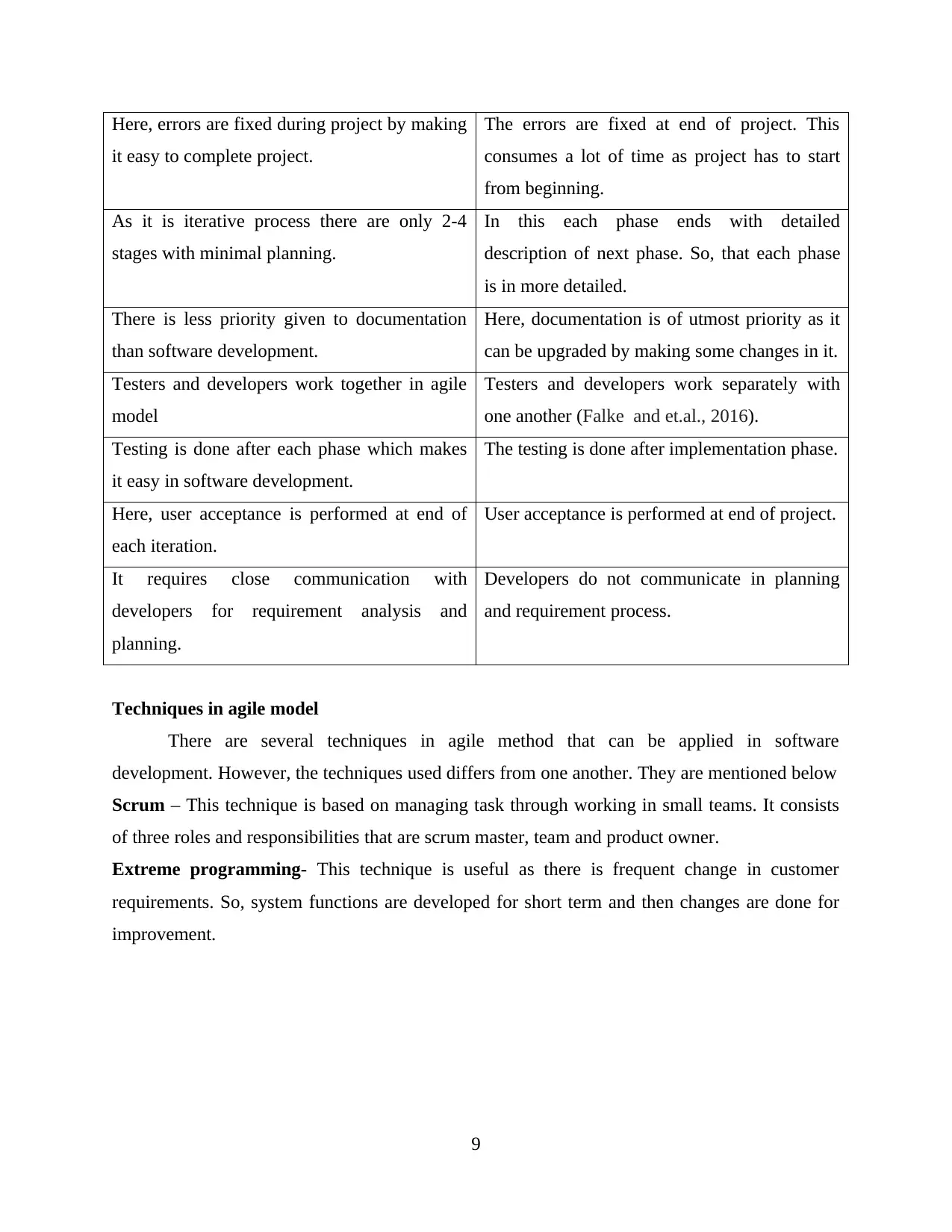
Here, errors are fixed during project by making
it easy to complete project.
The errors are fixed at end of project. This
consumes a lot of time as project has to start
from beginning.
As it is iterative process there are only 2-4
stages with minimal planning.
In this each phase ends with detailed
description of next phase. So, that each phase
is in more detailed.
There is less priority given to documentation
than software development.
Here, documentation is of utmost priority as it
can be upgraded by making some changes in it.
Testers and developers work together in agile
model
Testers and developers work separately with
one another (Falke and et.al., 2016).
Testing is done after each phase which makes
it easy in software development.
The testing is done after implementation phase.
Here, user acceptance is performed at end of
each iteration.
User acceptance is performed at end of project.
It requires close communication with
developers for requirement analysis and
planning.
Developers do not communicate in planning
and requirement process.
Techniques in agile model
There are several techniques in agile method that can be applied in software
development. However, the techniques used differs from one another. They are mentioned below
Scrum – This technique is based on managing task through working in small teams. It consists
of three roles and responsibilities that are scrum master, team and product owner.
Extreme programming- This technique is useful as there is frequent change in customer
requirements. So, system functions are developed for short term and then changes are done for
improvement.
9
it easy to complete project.
The errors are fixed at end of project. This
consumes a lot of time as project has to start
from beginning.
As it is iterative process there are only 2-4
stages with minimal planning.
In this each phase ends with detailed
description of next phase. So, that each phase
is in more detailed.
There is less priority given to documentation
than software development.
Here, documentation is of utmost priority as it
can be upgraded by making some changes in it.
Testers and developers work together in agile
model
Testers and developers work separately with
one another (Falke and et.al., 2016).
Testing is done after each phase which makes
it easy in software development.
The testing is done after implementation phase.
Here, user acceptance is performed at end of
each iteration.
User acceptance is performed at end of project.
It requires close communication with
developers for requirement analysis and
planning.
Developers do not communicate in planning
and requirement process.
Techniques in agile model
There are several techniques in agile method that can be applied in software
development. However, the techniques used differs from one another. They are mentioned below
Scrum – This technique is based on managing task through working in small teams. It consists
of three roles and responsibilities that are scrum master, team and product owner.
Extreme programming- This technique is useful as there is frequent change in customer
requirements. So, system functions are developed for short term and then changes are done for
improvement.
9
⊘ This is a preview!⊘
Do you want full access?
Subscribe today to unlock all pages.

Trusted by 1+ million students worldwide
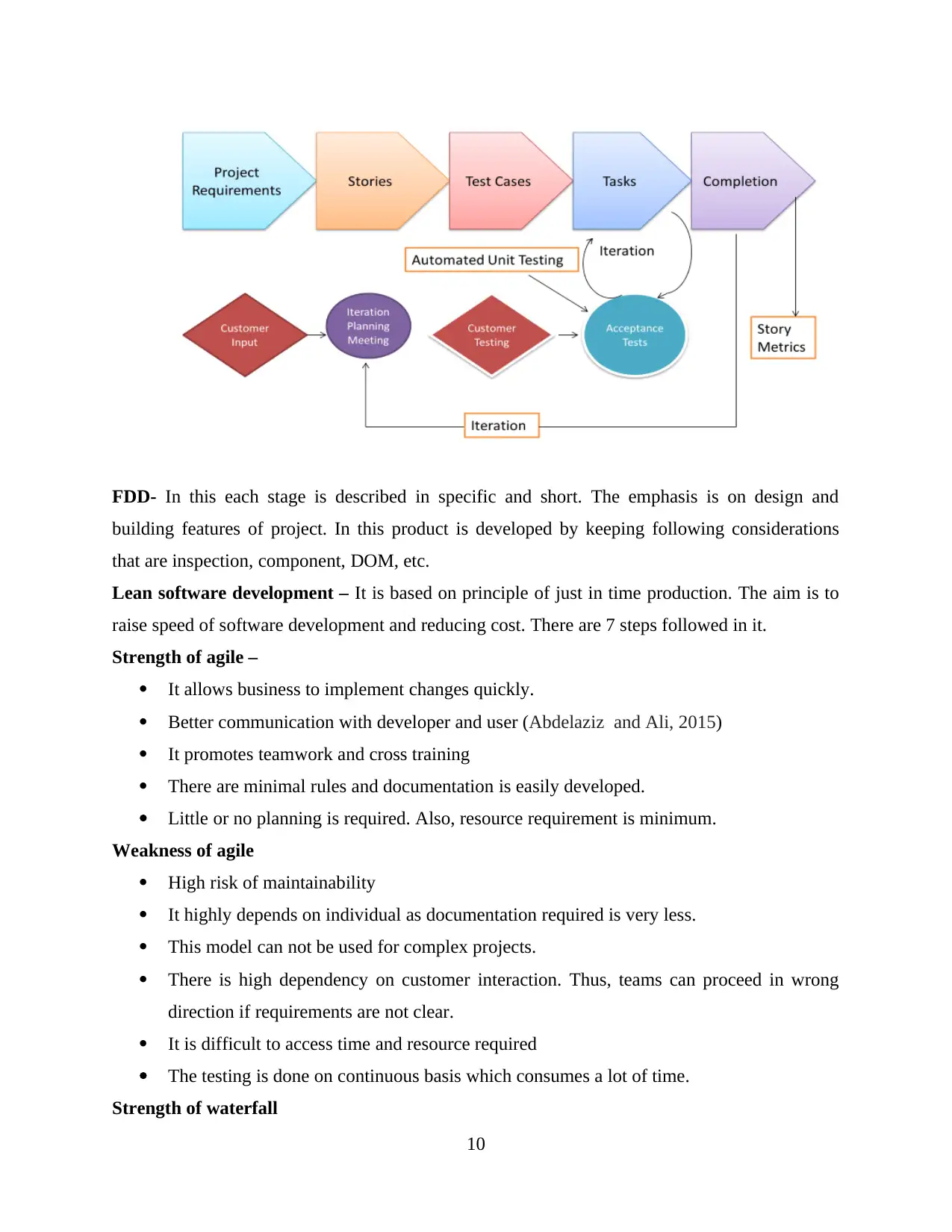
FDD- In this each stage is described in specific and short. The emphasis is on design and
building features of project. In this product is developed by keeping following considerations
that are inspection, component, DOM, etc.
Lean software development – It is based on principle of just in time production. The aim is to
raise speed of software development and reducing cost. There are 7 steps followed in it.
Strength of agile –
It allows business to implement changes quickly.
Better communication with developer and user (Abdelaziz and Ali, 2015)
It promotes teamwork and cross training
There are minimal rules and documentation is easily developed.
Little or no planning is required. Also, resource requirement is minimum.
Weakness of agile
High risk of maintainability
It highly depends on individual as documentation required is very less.
This model can not be used for complex projects.
There is high dependency on customer interaction. Thus, teams can proceed in wrong
direction if requirements are not clear.
It is difficult to access time and resource required
The testing is done on continuous basis which consumes a lot of time.
Strength of waterfall
10
building features of project. In this product is developed by keeping following considerations
that are inspection, component, DOM, etc.
Lean software development – It is based on principle of just in time production. The aim is to
raise speed of software development and reducing cost. There are 7 steps followed in it.
Strength of agile –
It allows business to implement changes quickly.
Better communication with developer and user (Abdelaziz and Ali, 2015)
It promotes teamwork and cross training
There are minimal rules and documentation is easily developed.
Little or no planning is required. Also, resource requirement is minimum.
Weakness of agile
High risk of maintainability
It highly depends on individual as documentation required is very less.
This model can not be used for complex projects.
There is high dependency on customer interaction. Thus, teams can proceed in wrong
direction if requirements are not clear.
It is difficult to access time and resource required
The testing is done on continuous basis which consumes a lot of time.
Strength of waterfall
10
Paraphrase This Document
Need a fresh take? Get an instant paraphrase of this document with our AI Paraphraser
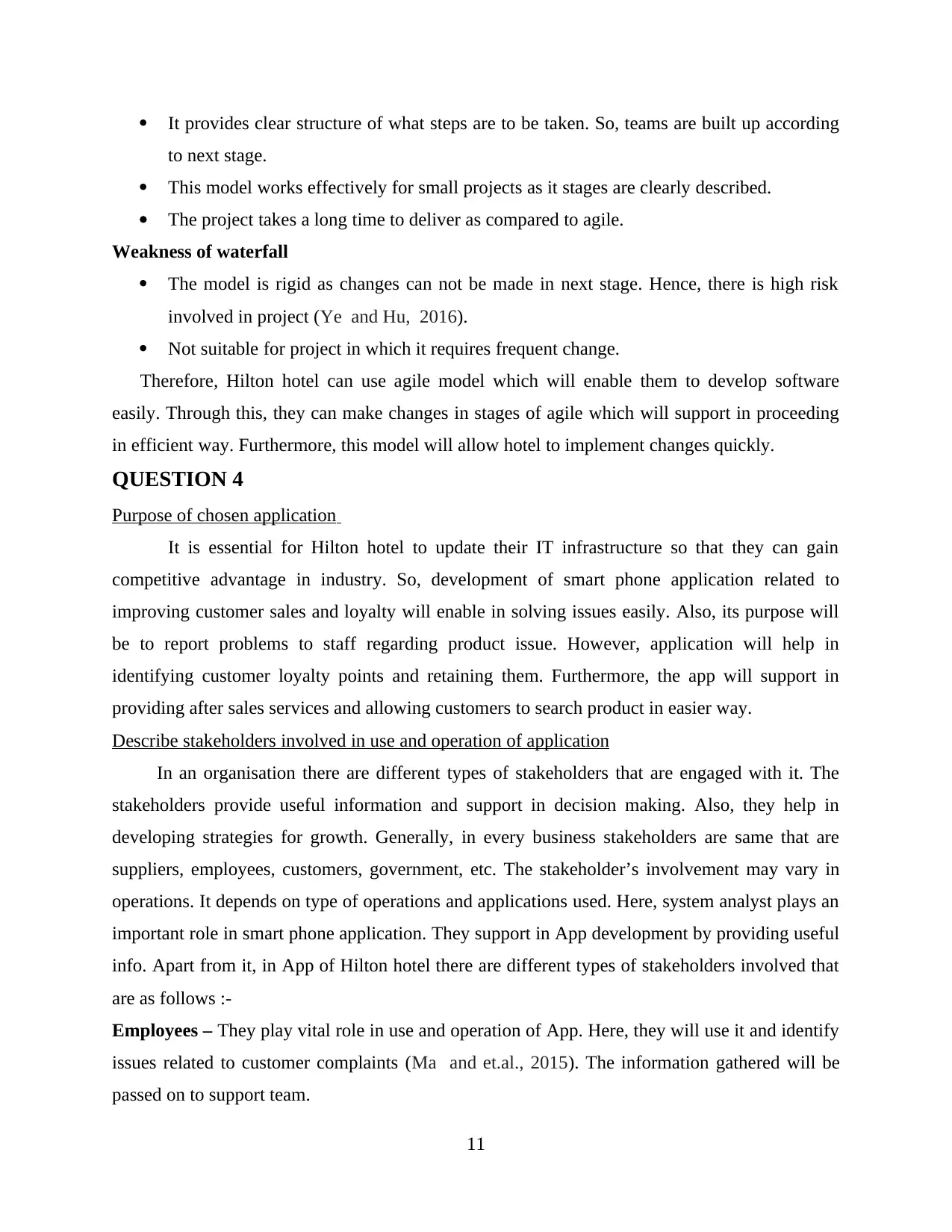
It provides clear structure of what steps are to be taken. So, teams are built up according
to next stage.
This model works effectively for small projects as it stages are clearly described.
The project takes a long time to deliver as compared to agile.
Weakness of waterfall
The model is rigid as changes can not be made in next stage. Hence, there is high risk
involved in project (Ye and Hu, 2016).
Not suitable for project in which it requires frequent change.
Therefore, Hilton hotel can use agile model which will enable them to develop software
easily. Through this, they can make changes in stages of agile which will support in proceeding
in efficient way. Furthermore, this model will allow hotel to implement changes quickly.
QUESTION 4
Purpose of chosen application
It is essential for Hilton hotel to update their IT infrastructure so that they can gain
competitive advantage in industry. So, development of smart phone application related to
improving customer sales and loyalty will enable in solving issues easily. Also, its purpose will
be to report problems to staff regarding product issue. However, application will help in
identifying customer loyalty points and retaining them. Furthermore, the app will support in
providing after sales services and allowing customers to search product in easier way.
Describe stakeholders involved in use and operation of application
In an organisation there are different types of stakeholders that are engaged with it. The
stakeholders provide useful information and support in decision making. Also, they help in
developing strategies for growth. Generally, in every business stakeholders are same that are
suppliers, employees, customers, government, etc. The stakeholder’s involvement may vary in
operations. It depends on type of operations and applications used. Here, system analyst plays an
important role in smart phone application. They support in App development by providing useful
info. Apart from it, in App of Hilton hotel there are different types of stakeholders involved that
are as follows :-
Employees – They play vital role in use and operation of App. Here, they will use it and identify
issues related to customer complaints (Ma and et.al., 2015). The information gathered will be
passed on to support team.
11
to next stage.
This model works effectively for small projects as it stages are clearly described.
The project takes a long time to deliver as compared to agile.
Weakness of waterfall
The model is rigid as changes can not be made in next stage. Hence, there is high risk
involved in project (Ye and Hu, 2016).
Not suitable for project in which it requires frequent change.
Therefore, Hilton hotel can use agile model which will enable them to develop software
easily. Through this, they can make changes in stages of agile which will support in proceeding
in efficient way. Furthermore, this model will allow hotel to implement changes quickly.
QUESTION 4
Purpose of chosen application
It is essential for Hilton hotel to update their IT infrastructure so that they can gain
competitive advantage in industry. So, development of smart phone application related to
improving customer sales and loyalty will enable in solving issues easily. Also, its purpose will
be to report problems to staff regarding product issue. However, application will help in
identifying customer loyalty points and retaining them. Furthermore, the app will support in
providing after sales services and allowing customers to search product in easier way.
Describe stakeholders involved in use and operation of application
In an organisation there are different types of stakeholders that are engaged with it. The
stakeholders provide useful information and support in decision making. Also, they help in
developing strategies for growth. Generally, in every business stakeholders are same that are
suppliers, employees, customers, government, etc. The stakeholder’s involvement may vary in
operations. It depends on type of operations and applications used. Here, system analyst plays an
important role in smart phone application. They support in App development by providing useful
info. Apart from it, in App of Hilton hotel there are different types of stakeholders involved that
are as follows :-
Employees – They play vital role in use and operation of App. Here, they will use it and identify
issues related to customer complaints (Ma and et.al., 2015). The information gathered will be
passed on to support team.
11
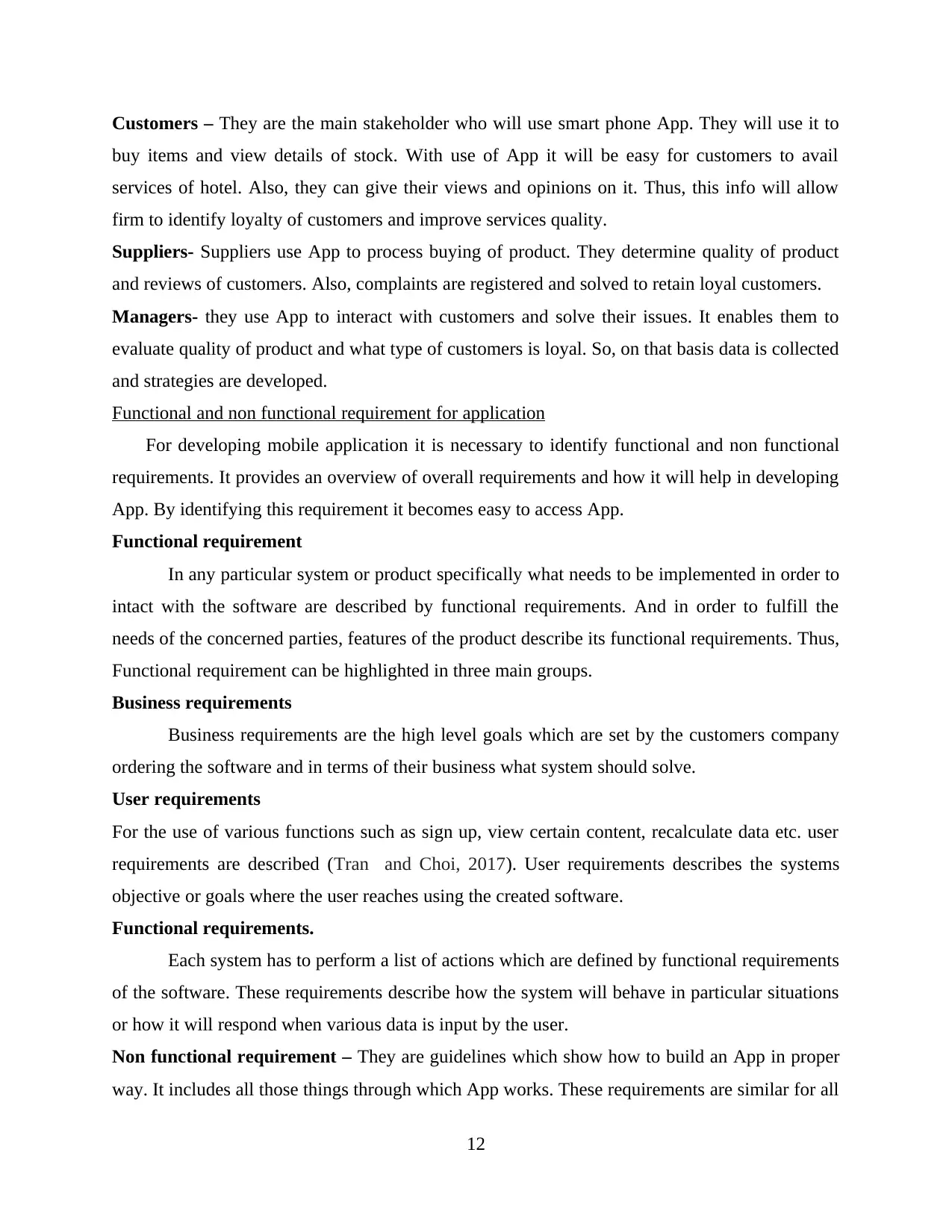
Customers – They are the main stakeholder who will use smart phone App. They will use it to
buy items and view details of stock. With use of App it will be easy for customers to avail
services of hotel. Also, they can give their views and opinions on it. Thus, this info will allow
firm to identify loyalty of customers and improve services quality.
Suppliers- Suppliers use App to process buying of product. They determine quality of product
and reviews of customers. Also, complaints are registered and solved to retain loyal customers.
Managers- they use App to interact with customers and solve their issues. It enables them to
evaluate quality of product and what type of customers is loyal. So, on that basis data is collected
and strategies are developed.
Functional and non functional requirement for application
For developing mobile application it is necessary to identify functional and non functional
requirements. It provides an overview of overall requirements and how it will help in developing
App. By identifying this requirement it becomes easy to access App.
Functional requirement
In any particular system or product specifically what needs to be implemented in order to
intact with the software are described by functional requirements. And in order to fulfill the
needs of the concerned parties, features of the product describe its functional requirements. Thus,
Functional requirement can be highlighted in three main groups.
Business requirements
Business requirements are the high level goals which are set by the customers company
ordering the software and in terms of their business what system should solve.
User requirements
For the use of various functions such as sign up, view certain content, recalculate data etc. user
requirements are described (Tran and Choi, 2017). User requirements describes the systems
objective or goals where the user reaches using the created software.
Functional requirements.
Each system has to perform a list of actions which are defined by functional requirements
of the software. These requirements describe how the system will behave in particular situations
or how it will respond when various data is input by the user.
Non functional requirement – They are guidelines which show how to build an App in proper
way. It includes all those things through which App works. These requirements are similar for all
12
buy items and view details of stock. With use of App it will be easy for customers to avail
services of hotel. Also, they can give their views and opinions on it. Thus, this info will allow
firm to identify loyalty of customers and improve services quality.
Suppliers- Suppliers use App to process buying of product. They determine quality of product
and reviews of customers. Also, complaints are registered and solved to retain loyal customers.
Managers- they use App to interact with customers and solve their issues. It enables them to
evaluate quality of product and what type of customers is loyal. So, on that basis data is collected
and strategies are developed.
Functional and non functional requirement for application
For developing mobile application it is necessary to identify functional and non functional
requirements. It provides an overview of overall requirements and how it will help in developing
App. By identifying this requirement it becomes easy to access App.
Functional requirement
In any particular system or product specifically what needs to be implemented in order to
intact with the software are described by functional requirements. And in order to fulfill the
needs of the concerned parties, features of the product describe its functional requirements. Thus,
Functional requirement can be highlighted in three main groups.
Business requirements
Business requirements are the high level goals which are set by the customers company
ordering the software and in terms of their business what system should solve.
User requirements
For the use of various functions such as sign up, view certain content, recalculate data etc. user
requirements are described (Tran and Choi, 2017). User requirements describes the systems
objective or goals where the user reaches using the created software.
Functional requirements.
Each system has to perform a list of actions which are defined by functional requirements
of the software. These requirements describe how the system will behave in particular situations
or how it will respond when various data is input by the user.
Non functional requirement – They are guidelines which show how to build an App in proper
way. It includes all those things through which App works. These requirements are similar for all
12
⊘ This is a preview!⊘
Do you want full access?
Subscribe today to unlock all pages.

Trusted by 1+ million students worldwide
1 out of 20
Related Documents
Your All-in-One AI-Powered Toolkit for Academic Success.
+13062052269
info@desklib.com
Available 24*7 on WhatsApp / Email
![[object Object]](/_next/static/media/star-bottom.7253800d.svg)
Unlock your academic potential
Copyright © 2020–2025 A2Z Services. All Rights Reserved. Developed and managed by ZUCOL.





